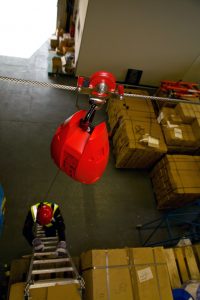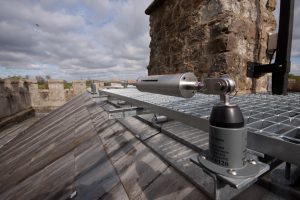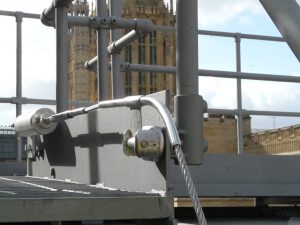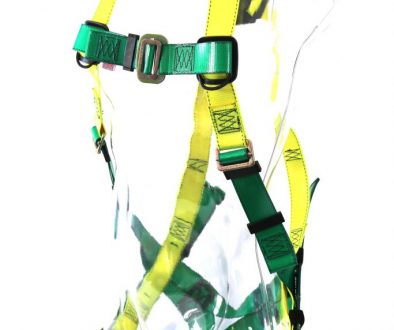5 Questions About Horizontal Lifelines
For more than 20 years, Webb-Rite Safety has been a premier provider of dependable, high-quality fall protection systems for customers in numerous industries. A family-owned business, we are dedicated to ensuring the safety of our customers, and make it our goal to furnish them with the latest fall protection technology on the market. To enhance customer safety, we are also pleased to offer a selection of training courses regarding OSHA guidelines and fall safety.
We design, engineer, manufacture, and install a variety of fall protection systems including a full line of quality horizontal lifeline systems.
 1. What is a horizontal lifeline?
1. What is a horizontal lifeline?
Horizontal lifelines, which are used at both overhead or foot levels, are typically installed on worksites where multiple workers are performing work from a great height or when free movement over an area is needed without having to constantly dis-attach and reattach to different anchor points. The lifeline typically consists of a wire rope or a synthetic fiber rope anchored and tensioned between two anchor points with intermediate anchor points on longer lengths. Workers attach themselves to the horizontal lifeline’s slider or shuttle using a variety of fall arrest equipment, such as a body harness, lanyard, and hooks.
2. Are fall protection cables the same as horizontal lifelines?
Horizontal lifelines are often referred to as fall protection cables. They are also known as cable fall protection systems, rat lines, and HLLs. At their most basic, horizontal lifelines incorporate a simple fiber or wire rope connected to a series of anchor points. A shuttle runs along the length of the rope, and workers connect to the shuttle using a lanyard and hook, in order to safely move along the line. It should be noted, though, that not all cable systems are horizontal lifelines, however.
3. How are horizontal lifelines inspected?
Due to the critical nature of horizontal lifelines on worksites, they should be inspected regularly. OSHA does not set forth particular requirements for inspection; however, ANSI standards recommend that fall protection systems be inspected at least once per year. Although many manufacturers follow ANSI standards, it is important to check the owner’s manual for your particular system and follow those guidelines.
Your horizontal lifelines should be inspected by a competent, knowledgeable professional. A standard inspection should include:
- Check fixtures and fasteners for damage or modifications
- Check components for corrosion, rust, and deterioration
- Inspect rope for damage
- Check for obstructions and abrasive materials that can compromise the system
- Look for broken or distorted sleeves and connectors
- View impact detection system to ensure that it has not been involved in a fall.
4. What are the OSHA guidelines for horizontal lifelines?
OSHA’s guidelines for horizontal lifelines are as follows:
(d)(8)
Horizontal lifelines shall be designed, installed, and used, under the supervision of a qualified person, as part of a complete personal fall arrest system, which maintains a safety factor of at least two.
(d)(9)
Lanyards and vertical lifelines shall have a minimum breaking strength of 5,000 pounds (22.2 kN).
5. How or when should you determine to use a horizontal lifeline?
The decision to use a horizontal lifeline is largely based on whether multiple workers will be working at a height above the ground. The number of workers, height of the workspace, and type of work being performed are also important factors to consider when choosing a fall protection system. Horizontal lifelines offer the unique advantage of safety coupled with freedom of movement that is ideal for situations that require a high degree of motion throughout the worksite.
Horizontal Lifelines Available at Webb-Rite
At Webb-Rite, we are committed to ensuring our customers safety by providing only the highest quality fall protection systems in the industry. Our selection of horizontal lifelines includes:
WRS Cable Span OH System
Our cable span overhead (OH) systems are installed with long spans between intermediate anchorage points, tension indicators, and in-line energy absorbers for optimal load transference, particularly in applications with limited intermediate anchor points.
WRS Cable Span System
Webb-Rite’s cable span system is for applications where an overhead installation is not feasible. The design features 300-grade electropolished stainless steel cables, intermediate brackets, and inline energy absorbers for corrosion-free protection in any weather.
WRS Roofline System
The WRS roofline is specifically designed for use on the edges of structures such as roofs, catwalks, and platforms. It incorporates a series of rubber-dampened posts, brackets, fasteners, and treatments that can be tailored to meet the particular needs of nearly any application.

Quality Fall Protection Systems From Webb-Rite
Since 1999, Webb-Rite has been a dedicated provider of superior fall protection systems. To learn more about our comprehensive fall protection systems, contact us today. For more information on OSHA regulations and fall protection, you can also view our training courses.

